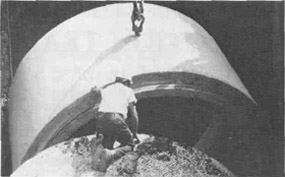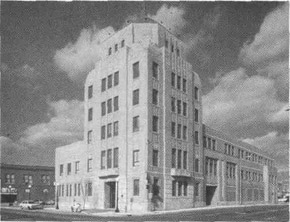SELECTING MEMBERS OF THE
PUBLIC WORKS CONSTRUCTION TEAM
By PAM BRUZAN
Design professionals - who, for the purposes of
this series, include architects or engineers - agree that
public works clients need to understand key aspects of
construction, especially how to select members of the
project team. This is the second of three articles that
introduces construction from a public works perspective, and it describes those procedures.
The series is co-sponsored as a public service by
the American Institute of Architects - Illinois, Central
Illinois Builders chapter of the Associated General
Contractors of America, Consulting Engineers
Council of Illinois and the Illinois Society for
Professional Engineers.
Bidding May Be Illegal?
Selecting a design professional through bidding is
usually illegal. The Brooks Act and the Architectural,
Engineering and Land Surveying Qualifications Based
Selection Act require federal and state agencies, respectively, to use Qualification-Based Selection (QBS)
in procuring architectural, engineering and land surveying services. The Local Government Professional
Services Selection Act applies to the selection of architects, engineers and land surveyors by most units of
local government. The process is also recommended
by all major professional design and contractor associations, the American Bar Association and client organizations such as the American Public Works
Association.
Some exceptions to the QBS mandate for local
government include:
• Home rule units of government or units of government representing more than 3,000,000 people,
• Prior established relationships with a design professional who is qualified to provide services for the
pending local government project, or
• Strictly defined justifiable emergencies.
QBS Facilitation
After George Heck, P.E., and Michael Hartigan,
P.E., retired from their respective engineering firms,
each became a volunteer QBS facilitator who provides
free services related to Qualification-Based Selection.
They represent professional design organizations by
explaining QBS and helping public entities set up a
QBS selection process.
The media equates no bidding with "sort of a gray
area of government," Hartigan notes. "They don't say
it's evil, but there's something sleazy about no bid . . .
My feeling is that QBS is really more competitive (than
price-based selection) and the more exacting of the
methodologies."
QBS also avoids potential problems, such as the
scenario that Hartigan terms "an invitation to disaster." In a bidding environment, design professionals
submit what they believe to be the lowest costs for services. Bids are based, however, on services the owners
think are needed, even though they can seldom paint
a complete picture of their needs at that stage. If owners later realize they inadvertently omitted something
from their bid documents, they may expect the additional service but refuse to pay extra. That's when "the
design people step out of the picture and the lawyers
step in," Hartigan says.
A Three-Step Process
Three broad steps of QBS, selection, project definition and retention, avoid such confrontations. "It
isn't complicated, and it makes sense," Heck says. QBS
offers the opportunity to establish a sound working relationship between an owner and architect or engineer.
Local government project owners first determine
if a firm that has provided prior design services is
qualified to complete the pending project. If it is necessary to look for a new design firm, a designated selection committee begins step one, selection. The committee prepares a preliminary scope of work and the
criteria, such as specialized experience and capabilities, by which to evaluate interested firms. These are
components of a request for proposal (RFP) or request
for qualifications (RFQ).
After evaluating all written responses, the selection committee prepares a short list of three-to-five
firms for further consideration and interviews.
Selection committees should ask about topics such as
the firm's current work load, the firm's track record in
cost estimating, expectations of the owner, anticipated
project issues and challenges, planned reviews with the
owner and construction-phase services.
Hartigan advises going beyond formal interviews.
He recommends talking with the people who work in,
operate or manage those facilities listed in the references and visiting each firm to talk with staff who will
be assigned to the project. One firm will emerge from
step one as exhibiting the best qualifications, project
understanding and rapport with the owner.
In step two, project definition, representatives of
the owner and the top-ranked firm define more fully
the project scope and required services based on project expectations, time constraints and budget limitations. Using their experience, design professionals
may offer suggestions that bring the project into sharper focus or clarify requirements owners may have not
yet considered.
By the end of step two, the owners and the design
professionals have agreed on the scope of the project
|
Pam Bruzan is the owner of Sangamon Valley Writing Associates,
a Rochester firm specializing in technical and promotional writing."*
|
November 1996 / Illinois Municipal Review / Page 5

Unlike selection of a design professional, selection of a contractor
by a public agency requires bidding for a design-bid-build project,
such as the recent rehabilitation of the Town Branch sewer in
Springfield.-(Photo is courtesy of the Consulting Engineers
Council of Illinois 1996 Engineering Excellence Awards program.)
|
and the required professional services, including the
possible evaluation of alternate solutions. If that agreement is not reached, they conclude their discussions,
and the owner opens talks with the firm ranked second.
During step three, retention, the owners and the
selected firm discuss fees, concurring on an acceptable
cost for those services agreed upon during step two. If
the owner and firm cannot agree on the terms of a
contract, they terminate their discussions, and the
owners turn to their next choice.
|
When Bidding is Required
Unlike selection of a design professional, selection
of a contractor by a public agency requires bidding for
a design-bid-build project. Differences between the
two selections are significant. When the design professional is chosen, owners generally are aware of their
needs, but frequently do not understand a complete
project scope. Construction bids are based on the design professionals' detailed plans and specifications from which specific material and labor costs can be determined.
Bids are usually awarded to the "lowest responsible
bidder." Responsible bidders have the financial capability to purchase materials and pay their crews. In addition, they have a satisfactory record of performance,
technical qualifications and equipment, and they will
be able to comply with the project schedule.
Jeffrey C. Evans, assistant vice president of Evans
Construction Company, Springfield, and Stuart W.
Broeren, president of Broeren Russo Construction,
Inc., Champaign, agree that public entities should
strongly consider prequalifying bidders. Prequalification requires that the prospective contractors fill
out a succinct form disclosing their financial and physical capability to perform the work. Evans says one disadvantage of prequalification is that newer contractors
have not yet developed a track record that demonstrates their capability.
|
Another display of a contractor's responsibility is
the ability to secure a bid bond and a performance
bond. Both are legal requirements for bidding on public works projects in Illinois. The purpose of the bid
bond, which normally is 5% to 10% of the bid, is to ensure that the low bidder will execute the contract.
Evans cautions that while the bond is an indication of
a firm's ability to complete the work, prequalification
of contractors may also be warranted, depending upon
the scope of the project. Broeren adds that once a
company proves its financial capability, it is difficult to
exclude them legally from bidding on a pending public project. Performance bonds ensure completion of a
project if the contractor should become unable to finish the work.
|

State and national laws require the selection
of architects and engineers using the Qualification-Based Selection
process. A recent renovation of the art deco Champaign City Administration
Building was combined with a significant addition to this historic
National Trust-eligible structure. The building received the
Heritage Award in Landmark Preservation from the Preservation
and Conservation Association of Champaign County.-(Photo is
courtesy of AIA Illinois.)
|
Project Delivery Alternatives
Project delivery refers to the type of relationships
that exist among the project owner, design professional and contractor during the life of the project.
Although different project delivery systems exist,
Evans recommends that public works entities must
carefully research them in order to determine if they
are legal and desirable for public works entities.
"Design-bid-build" is the most common form of
project delivery and is authorized by Illinois statutes.
The owner contracts with the architect or engineer,
seeks competitive bids from contractors and executes
a separate contract with the building contractor.
"Design-build" is an alternative system whereby
the owner contracts with one entity for design and
construction services.
Under "construction management," another party,
the construction manager, joins the team to oversee
what are usually complex projects with tight budgets
or schedules and a relatively greater need to coordinate consultants or subcontractors.
Preview
With the broad foundation of construction set,
owners are now ready to explore in more detail the
process of construction. These steps will be described
in the final article of this series. •
Page 6 / Illinois Municipal Review / November 1996